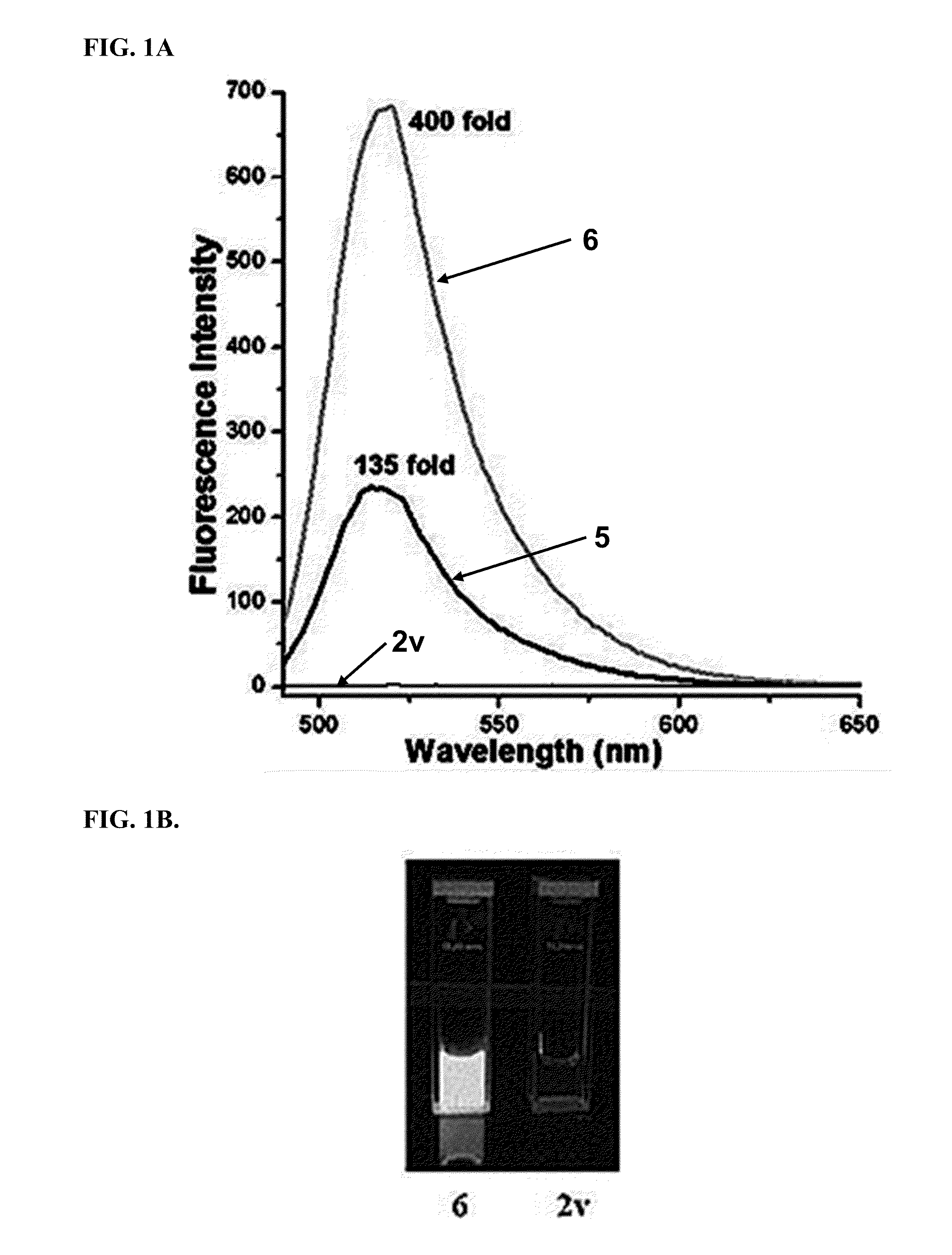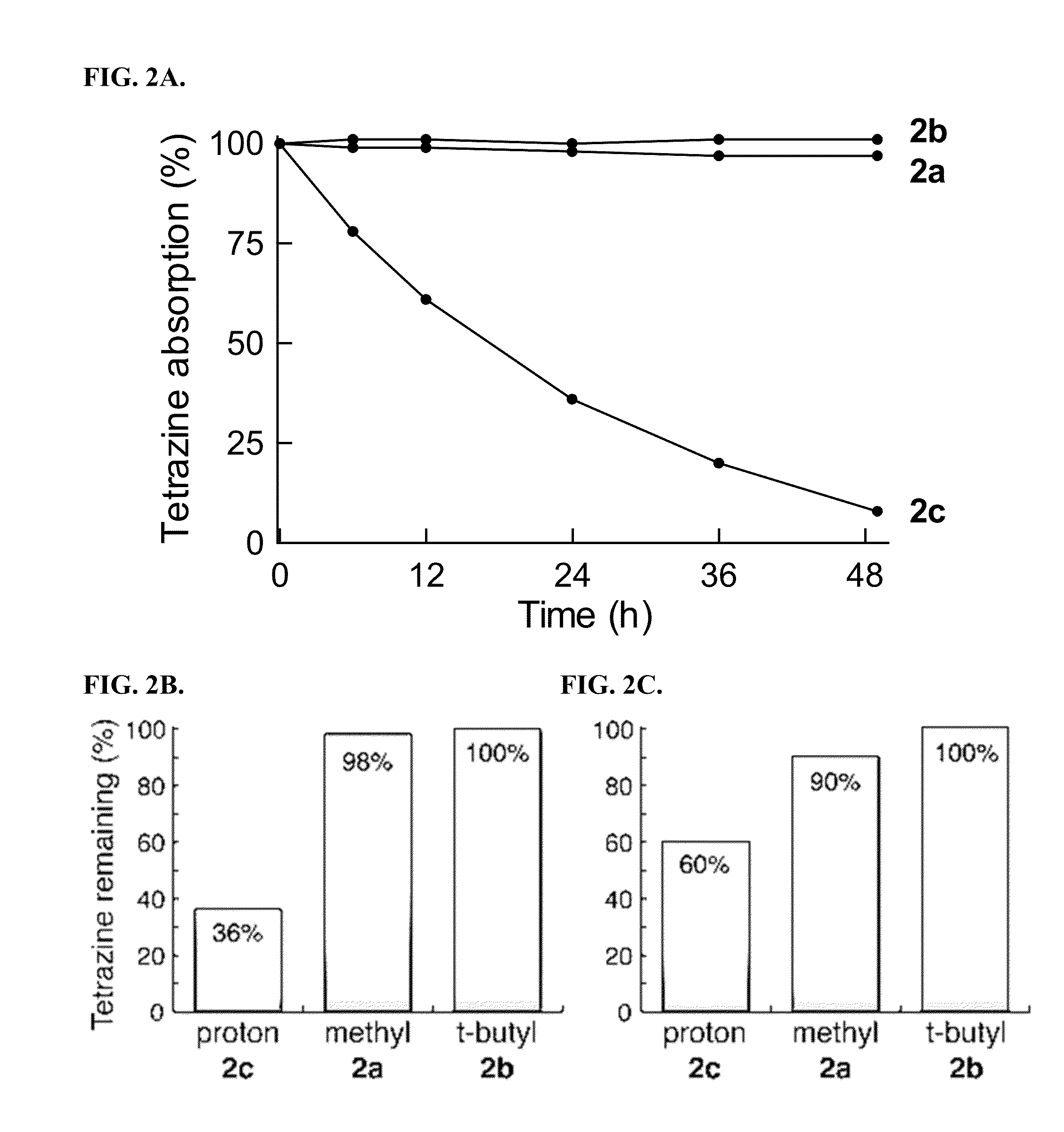Tetrazine-containing compounds and synthetic methods thereof
a technology of tetrazine and synthetic methods, which is applied in the direction of organic compounds/hydrides/coordination complexes, physical/chemical process catalysts, instruments, etc., can solve the problems of inability to use practical synthetic methods, hampered the development of new fluorescent tetrazine probes, particularly those with fluorogenic properties, and lack of practical synthetic methods
- Summary
- Abstract
- Description
- Claims
- Application Information
AI Technical Summary
Benefits of technology
Problems solved by technology
Method used
Image
Examples
example 1
Fluorescence Assays
[0202]All compounds were purified by HPLC and verified by LC-MS prior to quantitative activation experiments. Stock solutions in methanol were diluted into 1.5 mL of the appropriate solvent in a 1 cm×1 cm quartz cuvette. Measurements of solvent and pre-activation emission spectra for baseline values were made in at least triplicate, prior to addition of trans-cyclooctenol or cyclopropene 4 to initiate the fluorogenic reaction. 3-fold additional excess of trans-cyclooctenol and cyclopropene 4 were added for each fluorogenic reaction. Activation ratios were calculated from the peak emission intensity of the reaction product and the corresponding baseline intensity, and all the intensity data was background subtracted. Integration of the area under the emission intensity curves was used to validate the activation ratios.
[0203]For quantum yield determinations, fluorescein in 0.1M NaOH was used as a reference for compounds 5, 6, 9 and 10, with an excitation wavelength ...
example 2
Live Cell Imaging Studies
Synthesis of trans-cyclooctene NHS ((E)-cyclooct-4-en-1-yl (2,5-dioxopyrrolidin-1-yl) glutarate)
[0204]
[0205]DMAP (6.1 mg, 0.05 mmol) was added to a stirred solution of (E)-cyclooct-4-enol (5.0 mg, 0.040 mmol) in toluene (1.0 mL), followed by glutaric anhydride (6.0 mg, 0.05 mmol). The resulting reaction solution was heated to 100° C. and stirred at this temperature for 18 hours. After TLC indicated that the reaction had finished the solvent was evaporated and the residue was dissolved in CH2Cl2, followed by addition of N,N′-disuccinimidyl carbonate (13.0 mg, 0.05 mmol). After stirring at room temperature for 30 minutes, the reaction solution was evaporated and the residue was purified by preparative TLC (Hexanes:Ethyl Acetate (EtOAc)=2:1) to afford 7.0 mg product as a colorless liquid, in 51% yield. 1H NMR (500 MHz, CDCl3) δ 1.59-1.71 (2H, m), 1.89-2.05 (6H, m), 2.30-2.40 (6H, m), 2.68 (t, J=10 Hz, 2H), 2.83 (4H, bs), 4.42-4.45 (1H, t, m), 5.46-5.60 (2H, m);...
example 3
Synthesis of 3-methyl-6-hydroxyethyl-1,2,4,5-tetrazine Tza and 3, 6-hydroxyethyl-1,2, 4,5-tetrazine Tzd
[0208]
[0209]Following a previously developed procedure (Angew. Chem. Int. Ed. 2012, 51, 5222-5225), to a 50 mL flask equipped with a stir bar, Zn(OTf)2 (427 mg, 1.2 mmol), 3-hydroxy-propionitrile (285 mg, 4 mmol), acetonitrile (1.0 mL, 20 mmol), and anhydrous hydrazine (7.7 mL, 60 mmol) were added. The reaction was protected with a shield. Under the N2 gas, the mixture was stirred in an oil bath at 70° C. for 40 hours. The reaction solution was cooled with ice water, and sodium nitrite (40 mmol, 2.8 g) dissolved in 20 mL of ice water was slowly added, followed by slow addition of 1M HCl during which time the solution turned bright red, and gas evolved. Addition of 1M HCl continued until gas evolution ceased and the pH value was 3. The mixture was evaporated to remove the water and solvent, and EtOAc was added to the residue, and the solid was filtered. The filtrate was evaporated a...
PUM
| Property | Measurement | Unit |
|---|---|---|
| temperature | aaaaa | aaaaa |
| temperature | aaaaa | aaaaa |
| organic | aaaaa | aaaaa |
Abstract
Description
Claims
Application Information
 Login to View More
Login to View More - R&D
- Intellectual Property
- Life Sciences
- Materials
- Tech Scout
- Unparalleled Data Quality
- Higher Quality Content
- 60% Fewer Hallucinations
Browse by: Latest US Patents, China's latest patents, Technical Efficacy Thesaurus, Application Domain, Technology Topic, Popular Technical Reports.
© 2025 PatSnap. All rights reserved.Legal|Privacy policy|Modern Slavery Act Transparency Statement|Sitemap|About US| Contact US: help@patsnap.com



